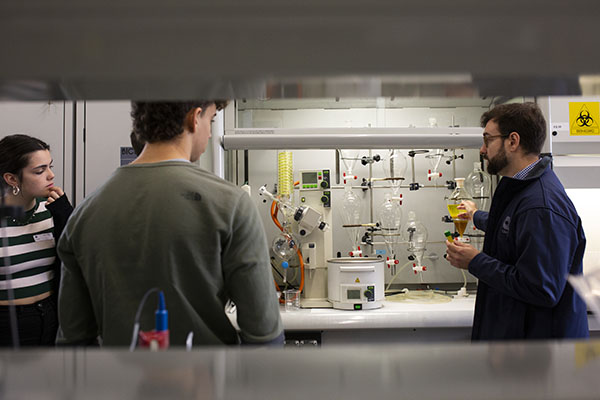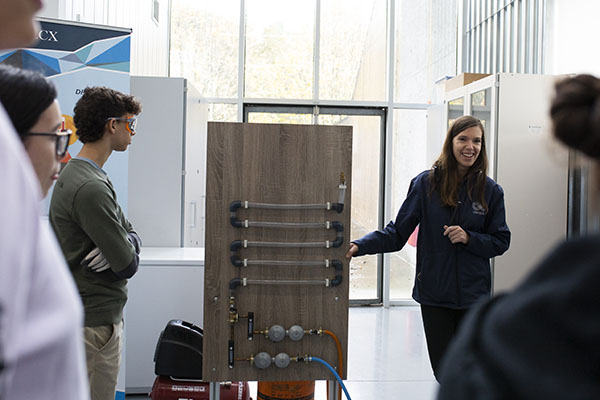Young technological baccalaureate students, students from the senior program and other senior groups participate in a new open day – November 15, 2022
With the motto “CINTECX for everyone”, a new open day was held in which from young technological baccalaureate students from the Beade, Carlos Casares and Castro de Vigo Secondary Education Institutes, to students from the seniors and Other groups of older people were able to learn first-hand about the research activity that Cintecx carries out in its six research areas: Electronics and automation, manufacturing and materials, energy, transportation, biomedical engineering, and sustainability and natural resources.
Activities
The students of the senior program and other senior groups were able to enjoy a guided tour in which they got to know the different laboratories and facilities of the center and the activities carried out by our researchers.
The high school students were divided into seven groups and two alternative routes were prepared through the center’s facilities. Each group was assigned one of the routes and given a treasure hunt map. They had to go looking for each of the laboratories/facilities that were indicated on the map, where the researchers from the center were waiting for them to explain different projects and activities and propose different tests that they had to pass in order to continue advancing in the treasure hunt. Once the tour was completed, a final kahoot test awaited them to verify the knowledge acquired during the visit and thus finally obtain the sought-after treasure.
Route 1
On this route, the students had to carry out and pass the following activities and tests.

Laser material processing
Guided by the researchers Félix Quintero and Ana Vilas, in this activity the students were able to discover the treatment of materials with lasers.

Corrosion: a problem, a solution and an opportunity

The researcher Gloria Pena proposed an experience based on corrosion and its use. With simple experiences and electrochemical methods, students were able to visualize anodic and cathodic reactions and classify metals based on their electrochemical potential, among other activities.
Biosurfactants: New Biodegradable Compounds
The researchers Xanel Vecino, Andrea Martínez and Alejandro spoke to the students about surfactants, focusing on biosurfactants, especially those obtained from corn washing liquor, a residue from the agri-food industry, and its various applications at the national level industrial.

Machinery assembly

The researchers Abraham Segade and Enrique Casarejos carried out a brief presentation/discussion with the students on how the analysis of machinery is faced today. As an example of a machine, they were explained how a manual jigsaw works, showing a 3D of its construction and the components it forms. The students were able to see the 3D assembly of a jigsaw and its components, having to assemble a jigsaw themselves and verify that all the components fit.
Mixed Reality
The activity prepared by the researchers Mercedes Solla, Jesús Balado, Enrique Bauzá and Álex Alonso began with an explanation about mixed reality and its difference with virtual reality. It also showed the most used applications today and in research on the HoloLens 2 glasses in civil engineering, architecture, design, and education. Students were able to participate in an interactive experience with glasses.

Dracarys

The researchers Ana Larrañaga, Raquel Pérez and Juan Jesús Rico carried out an experimental experience in which they explained what combustion is and carried out a flame propagation experiment that they also used to complete the explanation of the different types of flame and the concept of energy activation.
Final Activity: Kahoot
As a final test, the students participated in a Kahoot contest to test their knowledge. They had to answer a series of questions related to the activities carried out. The winners obtained the treasure, a special prize, although there were gifts and surprises for everyone.

Route 2
On this route the students had to carry out and pass these other activities and tests.

Biomaterials: from the laboratory to the clinic
Laura González brought the students closer to the history and use of biomaterials in an interactive way, being able to manipulate the devices and accessories developed by the group in situ.

Remediation of contaminated water

The researchers Aida Díez, Marta Pazos and Silvia Escudero introduced the students to the remediation processes for contaminated water (adsorption, Fenton process, etc.). Specifically, he told them about effluents contaminated with dyes.
Machine vision for mining
Guided by the researchers Iago Pozo, Xurxo Rigueira and María Pazo, the students carried out a mineral recognition gymkhana, where the participants relied on the use of artificial vision tools to identify ten minerals with different characteristics, their chemical formulation and most common uses.

Reverse engineering

The researchers Gabriel Fontela and Carlos Rivero showed the students how the 3D scanner works with different examples and practical activities.
Asynchronous motor, synchronous generator and rectifier test bench
In this activity, Alejandro Yepes, showed the students tests with a test bench that has different devices. A drive connected to the electrical network allows to control a three-phase asynchronous motor by means of V/f control.

Infrared thermography

In this activity, the researchers Miguel Martínez and Moisés Cordeiro introduced the students to the impact of thermographic analysis focused on energy efficiency to then explain infrared radiation and the theory of thermography. The activity ended with practical examples with the thermographic camera.
Final Activity: Kahoot
As in route 1, the students participated in a Kahoot contest to test the knowledge they acquired along their route and thus be able to finally obtain the treasure.

More images of the activity
Miraflores School of Ourense starts the first of the open days of the year 2022 in Cintecx- February 14, 2022.
Activities
Combustion workshop: “Combustion: The Sci-Ence Games
Guided by the researcher from the energy area, Raquel Orozco, students could learn from the easiest concepts to their applications to complex and real systems such as combustion engines, power generation plant, among others.
“Artificial intelligence: Once upon a time a world of data”
The researcher Jesus Rico explains to them in an interactive way the application of this new technologies to the world of engineering. In this case, they had to solve an artificial vision problem and learned the importance of the data compilation, development their problem –solving skills and imagination.
Mechanical and mechatronic design
In the Cintecx auditorium, students were able to fully immerse themselves in the mechanical and mechatronic design experiences proposed by the researchers Ángel Vilán, Gabriel Fontenla and Carlos Riveiro, who presented their projects such as the Xatcobeo satellite, the TitanRob submarine arm, the Demowave for harnessing tidal energy, artificial intelligence robots, early detection of forest fires, etc. As a surprise, there was time to develop interactive activities related to mechanics, in which the students tested their knowledge about the functioning of the reality around them.
Laboratory activities
In one of the center´s laboratories, led by researchers Iago Pozo, María Pazo and Xurxo Rigueira, the students in groups analyze in more detail the latest techniques used to extract dyes, going through laser and biological techniques, without forgetting the need to respect our built heritage. Also, the latest concerns at European level focused on the conservation of murals that constitute current street art were discussed.
Sustainable development and biotechnology
The program ended with the sustainable development and biotechnology activity, in which Xanel Vecino researcher from the Sustainability and Natural Resources area of CINTECX, guide the students in different experiments for the treatment of colored water using absorbents produced from waste and immobilization with alginate.















